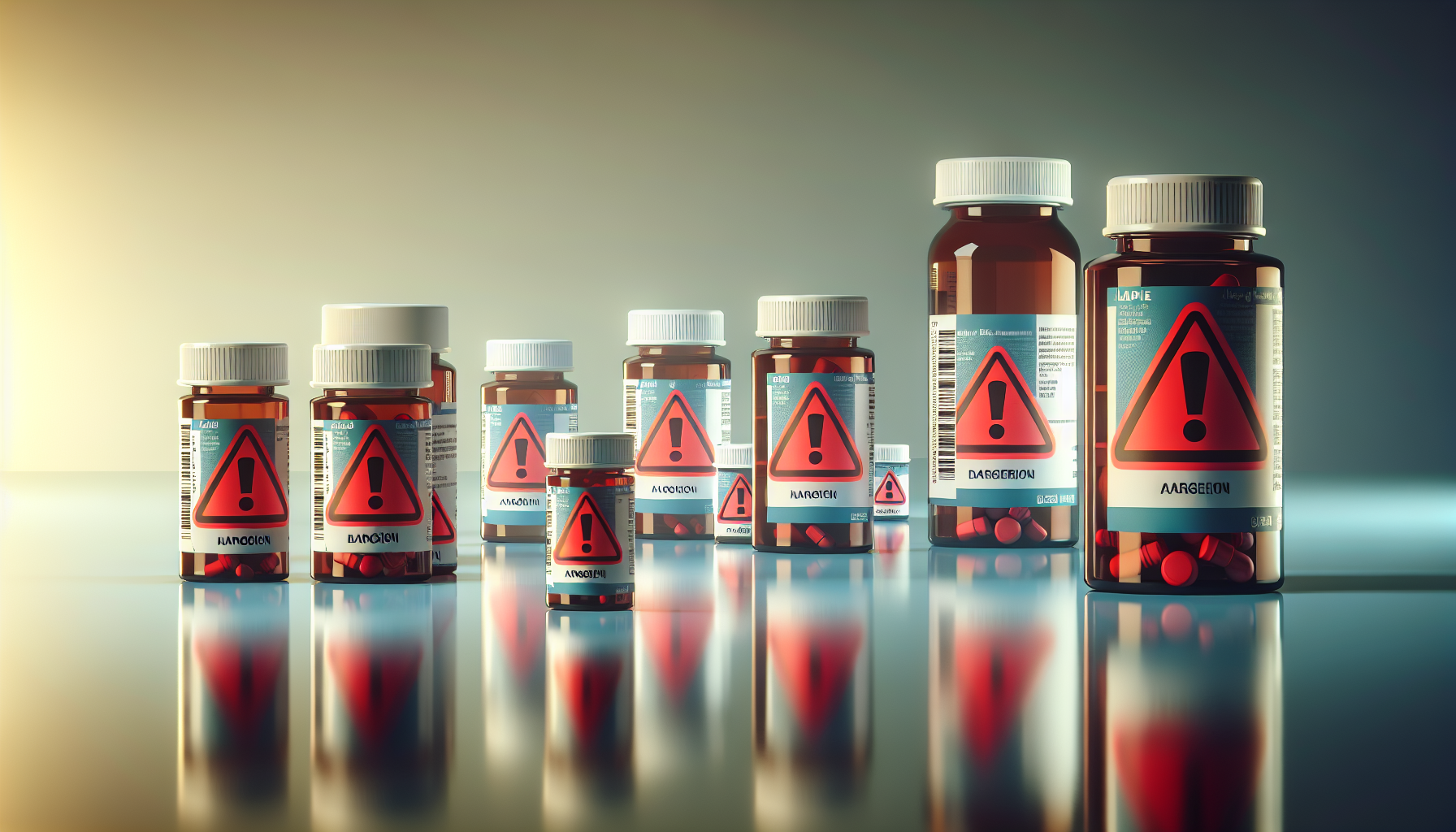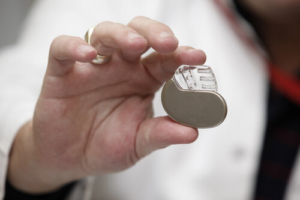Are you considering flecainide for treating an arrhythmia, or already on it and seeking more information about flecainide side effects? Flecainide is a medication that works by stabilizing the heart’s natural rhythm and is primarily used for abnormal heart rhythms like atrial fibrillation or SVT. This article provides a comprehensive guide examining the benefits, side effects, potential risks, and critical considerations for patients using flecainide. Understand how it works, when it’s prescribed, and the precautions necessary to ensure safe treatment.
Key Takeaways
- Flecainide is an anti-arrhythmic drug effective for treating conditions such as paroxysmal atrial fibrillation, supraventricular arrhythmias, and atrial flutter, acting by slowing abnormal electrical signals in the heart.
- Patients must closely monitor their health when starting on flecainide, adjust doses according to individual response and kidney function, and may utilize the Pill-in-the-Pocket technique for sporadic arrhythmia episodes.
- While flecainide is generally safe, there are potential side effects and drug interactions; it’s contraindicated in certain conditions, and doses may need adjustment for seniors, pregnant women, and individuals with various health conditions.
Understanding Flecainide
Flecainide, belonging to the class of anti-arrhythmic drugs, is very beneficial for patients grappling with conditions like paroxysmal atrial fibrillation or supraventricular arrhythmias. This medication works by acting on the sodium channels in the heart muscle to slow down abnormal electrical signals. This mechanism helps stabilize the heart rhythm and prevent abnormal heart rhythms.
The effects of flecainide are more pronounced in the atrial myocardium and the His-Purkinje system, assisting in keeping the heart rhythm normal by slowing abnormal nerve impulses.
Paroxysmal Supraventricular Tachycardia
Imagine facing sudden onset rapid heartbeats, a condition known as paroxysmal supraventricular tachycardia (PSVT), which can potentially lead to severe symptoms if left untreated. Flecainide can effectively treat these episodes. This medication is considered a common option for patients who do not respond to initial treatment with vagal maneuvers or adenosine, as evidenced by the cardiac arrhythmia suppression trial. In addition, flecainide may be used to prevent SVT episodes in patients with frequent episodes.
Further emphasizing its importance, flecainide is recommended for preventing SVT or symptoms from Wolff-Parkinson-White syndrome during pregnancy, presenting a safe and reliable solution.
Paroxysmal Atrial Fibrillation
Flecainide is a common first-line treatment for paroxysmal atrial fibrillation in patients without significant structural heart disease. It has proven efficacy in clinical trials for maintaining symptomatic control of atrial fibrillation, demonstrating its effectiveness in preventing episodes. Its well-tolerated nature, even with long-term use, signifies a positive safety profile for long-term management.
Flecainide shines particularly in controlling rhythm in paroxysmal atrial fibrillation, helping maintain sinus rhythm after cardioversion or minimizing episodes of paroxysmal AFib.
Atrial Flutter
When it comes to atrial flutter, flecainide shows its versatility. It is recommended to combine flecainide with a beta-blocker, verapamil, or diltiazem to maintain rate or rhythm control if atrial fibrillation or atrial flutter recurs, offering a comprehensive treatment approach for this heart rhythm disorder.
Starting Your Flecainide Treatment
Embarking on flecainide treatment is like setting sail on a voyage. It starts with an initial dose, followed by careful adjustments to navigate the waters of individual health conditions and responses. Along the journey, there’s also an intriguing option known as the Pill-in-the-Pocket technique, which might be suitable for certain situations.
Each step of the treatment, guided by a healthcare professional, is like a compass, leading you towards a stable heart rhythm and improved quality of life.
Initial Dose
Treatment with flecainide begins with a starting dose, typically being 50 mg twice a day for adults. This dose may change based on the condition being treated, with a maximum dose of 150 mg twice a day.
It is crucial to keep a keen eye on side effects during initiation of treatment. Monitoring heart rate, blood pressure, and ECG is vital to promptly address any serious side effects.
Dosage Adjustments
For flecainide treatment, dosage adjustments are made based on factors like kidney function, age, and clinical response. Patients with severely reduced kidney function start with a lower dose, recognizing that it takes longer to reach a new steady-state plasma level following a dosage adjustment.
For patients not well controlled on twice-daily dosing, they may benefit from dosing at eight-hour intervals. Gender differences, age-related decline in kidney function, and clinical response are other factors guiding these adjustments, ensuring the next dose is appropriate for the patient’s needs.
However, it is important not to abruptly discontinue flecainide after regular use; it is vital to consult a healthcare provider to safely and gradually reduce the dosage.
Pill-in-the-Pocket Technique
Imagine carrying a powerful weapon against arrhythmias in your pocket, ready to be deployed at the first sign of trouble. That’s the essence of the Pill-in-the-Pocket technique. This approach allows patients to carry flecainide at higher doses and take it as needed, only used when experiencing heart palpitations indicative of an atrial fibrillation or SVT episode.
It’s a technique suitable for those:
- with infrequent symptomatic paroxysmal atrial fibrillation or SVT
- aged between 18 and 75 years
- without significant chronic diseases such as severe renal or hepatic insufficiency.
- without structural heart disease such as CHF or significant CAD.
The flecainide dose for a pill in the pocket technique is usually higher then the usual prescribed amounts, with dose ranges from 100 mg to 300 mg noted for this technique.
Common Side Effects and Precautions
Although usually well tolerated, flecainide comes with its own set of challenges. The medication can cause common side effects and requires certain precautions to ensure a safe journey. But don’t worry, these challenges can be navigated with the right knowledge and guidance.
Flecainide Side Effects
Flecainide, like all medications, may cause side effects that vary in severity from mild to serious. Common side effects include dizziness, visual disturbances, and gastrointestinal discomfort such as nausea, vomiting, and constipation. Patients may also experience a sensation of lightheadedness or fatigue, which should be monitored closely as these symptoms can impact daily activities.
In some cases, more severe side effects may manifest, including palpitations, chest pain, or difficulty breathing. These symptoms could indicate a serious condition such as ventricular tachycardia, atrial flutter with rapid conduction, or other significant heart rhythm changes. If any of these severe side effects occur, medical attention should be sought immediately.
Additionally, there are rare side effects associated with flecainide that patients should be aware of. These include skin reactions, such as rash or itching, fever, and unexplained weakness or paralysis. A small number of patients may experience an increase in the severity of arrhythmias, a paradoxical effect that can be life-threatening and requires urgent medical intervention.
It is crucial for patients on flecainide to have regular follow-ups with their healthcare provider to monitor for any adverse effects. Electrocardiograms (ECGs) and possibly blood tests may be used to assess the patient’s response to the medication and to ensure that the drug levels remain within a therapeutic range. Patients should be educated on the importance of reporting any side effects, however minor they may seem, to their healthcare provider.
Precautions
Taking precautions with flecainide can ensure a safer treatment. Some of these precautions include:
- Responsibly storing the medication away from children
- Adhering to the doctor’s guidance on diet, beverages, and activity
- Not sharing the medication with others
- Avoiding consumption of goji berries, which can cause drug toxicity by inhibiting the CYP2D6 enzyme responsible for flecainide metabolism.
Flecainide Interactions
Flecainide may interact with other medications, including quinidine, digoxin, and certain heartburn medications. These interactions can affect the effectiveness of the medication, highlighting the importance of careful management of the medication regimen.
Drug Interactions
Certain medications can interact with flecainide and potentially affect treatment and increase side effects. These include:
- Amiodarone
- Cisapride
- Pimozide
- Quinine
- Several antidepressants
- Antimalarials
- Cimetidine
- Dofetilide
Flecainide may also lead to an increased risk of QT or QRS prolongation on ECG, especially in patients with low levels of potassium or magnesium in the blood.
Contraindications and Warnings
There are specific contraindications and warnings associated with flecainide use. These conditions and warnings should be carefully considered to ensure a safe journey.
Contraindications
There are certain conditions under which the use of flecainide is contraindicated. These include:
- Known hypersensitivity to the drug
- Cardiogenic shock
- Preexisting second or third-degree AV block
- Right bundle branch block associated with a left hemiblock, unless a functioning pacemaker is present.
- History of congestive heart failure with significant left ventricular dysfunction
- History of significant coronary artery disease, especially patients with recent myocardial infarction.
Alternative Anti-Arrhythmic Drugs
There are alternative anti-arrhythmic drugs to flecainide when it is either ineffective or not tolerated. These alternatives include:
- Amiodarone
- Sotalol
- Dronedarone (Multaq)
- Propafenone
- Quinidine
- Dofetilide
Each of these drugs offers a different path to the same destination – maintaining a regular heart rhythm.
Monitoring and Clinical Response
Navigating a journey with flecainide requires vigilance. Regular monitoring and assessment of clinical response are integral parts of the treatment. This includes regular check-ups for dose adjustments, continuous EKG monitoring, and scheduled follow-up visits with healthcare providers.
Special Considerations
Every patient’s journey with flecainide is unique. Special considerations need to be made for different groups of patients including older adults, children, and pregnant or breastfeeding individuals.
Pregnancy and Breastfeeding
Navigating the journey of pregnancy and breastfeeding with flecainide requires a steady hand at the helm. While flecainide can be used during pregnancy, it is recommended to avoid anti-arrhythmic medications in the first trimester if possible.
Likewise, while flecainide does pass into breast milk, it is unlikely to harm a nursing infant. However, consultation with a doctor is recommended before breastfeeding while taking flecainide.
Seniors
For older adults on flecainide, there are special considerations to be made. Due to slower drug metabolism and clearance associated with aging, dosages might need to be adjusted. Careful monitoring of blood pressure, serum trough concentrations, and regular EKGs are necessary for this group of patients.
Pediatric Use
Flecainide can be safely used in pediatric patients to treat SVT or paroxysmal atrial fibrillation. The dosing in pediatrics patients is dependent on the patient’s age, and size.
Summary
Flecainide, as an antiarrhythmic drug, plays a pivotal role in helping manage heart rhythm disorders. However, like any journey, it requires careful navigation, constant monitoring, and a willingness to adapt based on individual responses and conditions. Remember, the journey is as important as the destination, and understanding the nuances of flecainide treatment empowers you to undertake this voyage with confidence and informed decision-making.
Frequently Asked Questions
Why is flecainide high risk?
Flecainide is considered high risk due to its rare association with potential allergic reactions, heart attacks in individuals with a history of heart attacks, and the risk of new or worsened arrhythmias, including a rare but serious fast/irregular heartbeat.
What does flecainide do to the heart?
Flecainide slows or blocks sodium electrical signals in the heart and stabilizes the heartbeat, treating potentially life-threatening irregular heartbeats like paroxysmal supraventricular tachycardia (PSVT) or AFib.
Foods to Avoid with Flecainide
Certain foods should be avoided when taking flecainide as they can interact with the medication and affect its efficacy. It is recommended to steer clear of grapefruit and grapefruit juice, which can increase the levels of flecainide in your bloodstream and lead to adverse effects.
Additionally, caffeine-containing foods and beverages may exacerbate the side effects of Flecainide, such as heart palpitations and tremors. Patients should also avoid excessive consumption of goji berries, which can inhibit the metabolism of flecainide and potentially lead to toxicity. Always consult with your healthcare provider for a comprehensive list of foods to avoid tailored to your specific health needs.
Is flecainide a beta blocker?
No, flecainide is not a beta blocker. It is a sodium channel-blocking drug that slows conduction within the heart. This helps in its main purpose of acting on the atria and slowing conduction through the AV-node.
What is flecainide 50 mg used for?
Flecainide 50 mg is used to treat irregular heartbeats such as paroxysmal supraventricular tachycardia (PSVT) and to prevent life-threatening sustained ventricular tachycardia. It can slow or block electrical signals in the heart and stabilize the heartbeat, effectively treating potential life-threatening irregularities.
The Best Atrial Fibrillation Book
Your Complete Guide To AFib: The Essential Manual For Every Patient With Atrial Fibrillation
$15.95 (as of April 29, 2024 10:33 GMT -06:00 - More infoProduct prices and availability are accurate as of the date/time indicated and are subject to change. Any price and availability information displayed on [relevant Amazon Site(s), as applicable] at the time of purchase will apply to the purchase of this product.) The A to Z guide on everything you need to know about atrial fibrillation. Written by AFib expert Dr. Percy Morales MD. Over 120 pages of essential information on medications, procedures, and lifestyles modifications for AFib. Easy to read for every patient.
Shop AFib Products on Amazon
KardiaMobile 6-Lead Personal EKG Monitor – Six Views of The Heart – Detects AFib and Irregular Arrhythmias – Instant Results in 30 Seconds – Works with Most Smartphones - FSA/HSA Eligible

KardiaMobile 1-Lead Personal EKG Monitor – Record EKGs at Home – Detects AFib and Irregular Arrhythmias – Instant Results in 30 Seconds – Easy to Use – Works with Most Smartphones - FSA/HSA Eligible

Apple Watch Series 9 [GPS 41mm] Smartwatch with Storm Blue Aluminum Case with Silver Sport Band M/L. Fitness Tracker, Blood Oxygen & ECG Apps, Always-On Retina Display

Fitbit Sense 2 Advanced Health and Fitness Smartwatch with Tools to Manage Stress and Sleep, ECG App, SpO2, 24/7 Heart Rate and GPS, Shadow Grey/Graphite, One Size (S & L Bands Included)

OMRON - Complete Wireless Upper Arm Blood Pressure Monitor + EKG - Built-in Bluetooth Technology
24% Off
Omron Hem 7361T Bluetooth Digital Blood Pressure Monitor with Afib Indicator and 360° Accuracy Intelliwrap Cuff for Most Accurate Measurements (White)
$127.99 (as of April 30, 2024 03:06 GMT -06:00 - More infoProduct prices and availability are accurate as of the date/time indicated and are subject to change. Any price and availability information displayed on [relevant Amazon Site(s), as applicable] at the time of purchase will apply to the purchase of this product.)
EMAY Portable ECG Monitor | Record ECG and Heart Rate Anytime Anywhere | Stand-Alone Device with LCD Screen and Storage | No Subscription Required

SAMSUNG Galaxy Watch 6 44mm Bluetooth Smartwatch, Fitness Tracker, Personalized HR Zones, Advanced Sleep Coaching, Heart Monitor, BIA Sensor, Health Wellness Insights, Big Screen, US Version, Graphite

Natural Rhythm Triple Calm Magnesium 150 mg - 120 Capsules – Magnesium Complex Compound Supplement with Magnesium Glycinate, Malate, and Taurate. Calming Blend for Promoting Rest and Relaxation.

Pure Encapsulations Magnesium (Glycinate) - Supplement to Support Stress Relief, Sleep, Heart Health, Nerves, Muscles, and Metabolism* - with Magnesium Glycinate - 180 Capsules






















![Apple Watch Series 9 [GPS 41mm] Smartwatch with Storm Blue Aluminum Case with Silver Sport Band M/L. Fitness Tracker, Blood Oxygen & ECG Apps, Always-On Retina Display #1](https://m.media-amazon.com/images/I/311xwtp4mFL._SL100_.jpg)
![Apple Watch Series 9 [GPS 41mm] Smartwatch with Storm Blue Aluminum Case with Silver Sport Band M/L. Fitness Tracker, Blood Oxygen & ECG Apps, Always-On Retina Display #2](https://m.media-amazon.com/images/I/41j+8AaUGsL._SL100_.jpg)
![Apple Watch Series 9 [GPS 41mm] Smartwatch with Storm Blue Aluminum Case with Silver Sport Band M/L. Fitness Tracker, Blood Oxygen & ECG Apps, Always-On Retina Display #3](https://m.media-amazon.com/images/I/41jIyxZitnL._SL100_.jpg)
![Apple Watch Series 9 [GPS 41mm] Smartwatch with Storm Blue Aluminum Case with Silver Sport Band M/L. Fitness Tracker, Blood Oxygen & ECG Apps, Always-On Retina Display #4](https://m.media-amazon.com/images/I/41IpNJERjCL._SL100_.jpg)
![Apple Watch Series 9 [GPS 41mm] Smartwatch with Storm Blue Aluminum Case with Silver Sport Band M/L. Fitness Tracker, Blood Oxygen & ECG Apps, Always-On Retina Display #5](https://m.media-amazon.com/images/I/31o17yhfYpL._SL100_.jpg)

















































